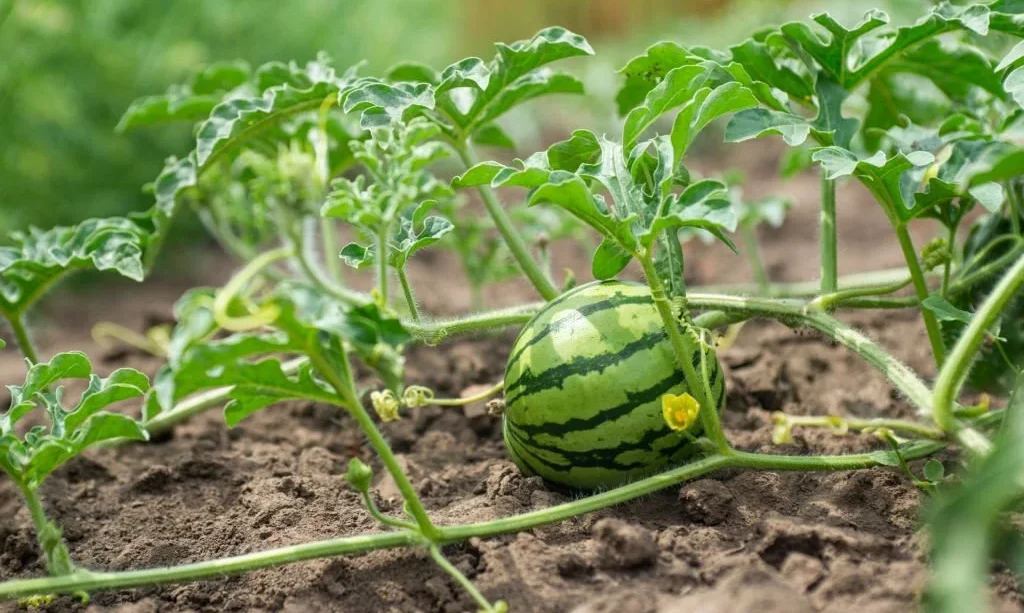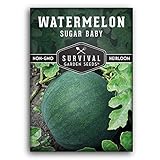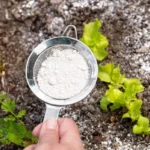Hello, gardening enthusiasts and watermelon lovers! Have you ever found yourself dreaming of plucking a juicy, sun-warmed watermelon right from your own backyard, but stopped short because of limited space? Well, it’s time to shake off those misconceptions. Growing watermelons in small spaces might seem like a giant task, but with the right knowledge and a touch of patience, it is absolutely achievable! This article aims to guide you through the process, transforming your small space into a thriving watermelon patch.
- Citrullus Lanatus: These finest quality, non-GMO, USDA Organic Crimson Sweet Watermelon seeds produce striped, nearly round, 15-25 pound melons with sweet, crisp, crimson flesh and small seeds perfect for juicy summer treats.
- Looking for an Earlier Harvest? Start seeds indoors 3-4 weeks before the last frost date and transplant seedlings to a sunny location, with light, porous soil, after the soil warms to about 60° F.
- Freshly Packed: These seeds are packed for the current growing season and will provide high germination rates next year as well.
- Certified Organic: All Purely Organic Seeds are open pollinated, non-GMO (not genetically modified), heirloom, organic seeds. Each Purely Organic Seed Packet carries the USDA Organic Seal signifying that is has passed rigorous standards and been certified organic by a USDA Accredited agency.
- Premium Packaging: All seeds from Purely Organic Products are packaged in individually styled packets ideal for gifts, storage or immediate use. Each packet displays the plant variety on the front with instructions and plant facts on the back.
Watermelon Needs
Just like humans, plants too have their preferences, and watermelons are no exception. Understanding what they need can be the game-changer for your home-grown melon experience. Let’s break it down.
- Light Requirements: The sun is your watermelon plant’s best friend. Aim for a spot that receives at least six to eight hours of sunlight daily.
- Temperature and Climate Suitability: Watermelons love warmth! They need a growing season of at least 80 to 100 frost-free days. If you live in a cooler area, don’t worry; we’ll discuss suitable varieties later on.
- Soil Conditions: Your soil is the foundation of your watermelon garden. They prefer well-drained, loamy soil that’s rich in organic matter with a pH between 6.0 and 7.0.
- Watering Needs: While their name might suggest they love lots of water, it’s a balancing act. Watermelons need regular, deep watering, but overdoing it can lead to waterlogged soil and diseased plants.
Choosing the Right Watermelon Variety
Yes, watermelons come in all shapes and sizes, and choosing the right one can make all the difference in your small-space garden.
- Sugar Baby Watermelons: These are your best bet if you’re tight on space. They are smaller in size but packed with sweetness, perfect for a summer treat.
- Bush Sugar Baby: A cousin of the Sugar Baby, this variety is bred specifically for container gardening. The vines are compact, and the fruit is small but flavorful.
Remember, no matter where you get your seeds from, ensure they are from a reputable supplier. Healthy seeds lead to healthy plants. Stay tuned as we move to the next steps in our watermelon-growing journey!
- Summer Flavor – Small 6-10 pound round watermelons are packed with sweetness and fit perfectly in the bottom of your fridge or icebox.
- Summer Flavor – Small 6-10 pound round watermelons are packed with sweetness and fit perfectly in the bottom of your fridge or icebox.
- Compact Vines – Sugar Baby watermelons vines are compact and space saving while being very productive.
- Grow Now or Later – Plant now or store for future growing seasons. Will remain viable for years if stored in a cool dry location. Each packet has instructions for saving seeds so you can perpetuate your harvest and share with others.
- Easy to Grow – Seeds are packed in a beautiful paper packet with instructions for successful growing and germination in your own home garden. Getting started is simple for both beginner and experienced gardeners.
Preparing the Growing Space
Time to roll up your sleeves and get your hands dirty because we’re about to prep our growing space. It’s like setting the stage for our watermelon stars to shine!
- Soil Preparation: Start by breaking up your soil and mixing in lots of organic matter or compost. This boosts the fertility and ensures your plants will have the nutrients they need to grow big and strong.
- Maximizing Small Spaces: Small doesn’t mean impossible! Consider vertical gardening – train your watermelon vines up a trellis or fence to save ground space. If you’re going the container route, pick a large pot (at least 5 gallons) and make sure it has good drainage.
- Irrigation Setup: Setting up a simple drip irrigation system can help you water your plants more efficiently, ensuring water gets right to the roots where it’s needed.
Planting the Seeds
Finally, the moment we’ve been waiting for – it’s time to plant our seeds!
- When to Plant: The best time is after the last spring frost when the soil has warmed up. Watermelon seeds need warm soil to germinate!
- Depth and Spacing: Plant your seeds about 1 inch deep in the soil. If you’re planting multiple seeds, space them about 2 feet apart.
- Initial Care: Keep the soil moist but not soggy after planting. Your seeds should sprout in 7 to 14 days.
- NUTRIENT RICH & INDOOR/OUTDOOR FAST GERMINATION… Wonder Soil Premium Organic Potting Soil Mix is the only dry compressed coco coir mix with added amendments of worm castings, mycorrhizae, kelp, perlite and more! Grow your plants faster with stronger roots! Peat free, all natural, family and pet safe!
- A LITTLE DOES A LOT… your little BIG bag of compressed indoor potting soil & garden soil for outdoor plants expands to 4 TIMES THE SIZE when mixed with water; easy to carry & saves vital shed space.
- PRE-MIXED & READY TO USE ORGANIC POTTING MIX … Pre-mixed and ready to use organic potting soil and garden soil mix to help make your gardening or hobby growing a breeze. Simply transplant your desired plants into their new container and add our soil mix or pour our soil mix and plant your seeds.
- WATER RETENTION & DRAINAGE… Coco coir has excellent water retention with dependable drainage and aeration in the root zone. Save up to 50% of water, fertilizer, and seed!
- HEAVY DUTY RESEALABLE BAG… Use what you need and save the rest for later! Keeping your planting soil dry and safe!
Caring for Your Watermelon Plants
Now that our seeds are in the ground, it’s time to take care of them as they grow.
- Watering: Keep your soil moist but make sure it’s not waterlogged. A deep watering once a week should do the trick.
- Fertilizing: Feed your watermelon plants with a balanced fertilizer to help them grow. Remember, over-fertilizing can harm your plants, so it’s better to underdo it than overdo it.
- Sunlight: Make sure your plants are getting at least six to eight hours of sunlight every day.
- Pest and Disease Prevention: Keep an eye out for any signs of pests or disease. Act fast if you notice anything out of the ordinary.
As you tend to your growing plants, you’re one step closer to harvesting your home-grown watermelons. Stay tuned for the next steps in our journey!
Harvesting Your Watermelons
The anticipation is over – your watermelons are ready to be picked! But when is the perfect moment? Let’s find out.
- Signs of Readiness: Check the bottom of the watermelon, the side resting on the ground. If it’s turned from white to a rich yellow, it’s time. Another clue is the tendril – the curly pigtail-like part – nearest to the fruit. If it has dried and turned brown, your watermelon is ready for harvest!
- Harvesting: Use a sharp knife or pruning shears to cut the watermelon, leaving about an inch of stem on the fruit. This prevents the watermelon from rotting after it’s picked.
- Storing and Consuming: After harvesting, you can store your watermelon at room temperature for about 10 days. Once cut, refrigerate the slices and eat within a few days to enjoy its peak freshness.
Troubleshooting Common Issues
Just like every great journey, you might face some obstacles. Don’t worry, we’ve got you covered!
- Common Problems: Yellow leaves? Tiny fruits? These could be signs of nutrient deficiencies. Try adding a balanced fertilizer to your soil.
- Pest and Disease Management: Keep an eye out for pests like aphids or signs of disease like mildew. If you notice anything, don’t panic! There are many natural solutions available.
- Space-related Challenges: If your plants are looking cramped, consider moving them to a larger container or pruning the vines.
Conclusion
And there you have it – a crash course in growing watermelons in a small space. From understanding their needs to harvesting your juicy, home-grown melon, we’ve covered it all. Remember, every green thumb was once a seedling, so don’t worry if you make some mistakes along the way. It’s all part of the growing journey.
We hope this guide inspires you to turn your small space into a thriving watermelon patch. Stay tuned for more gardening adventures and happy planting!







